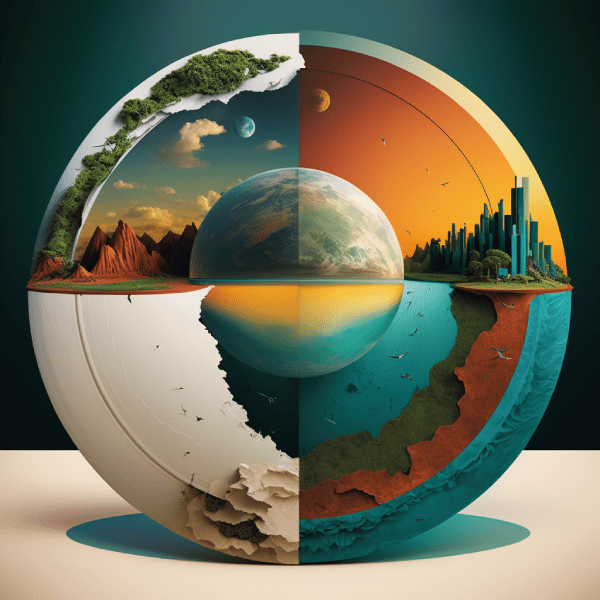Introduction
In today’s world, we are more connected than ever, with the majority of our daily activities now taking place online. Whether it’s shopping, working, or communicating with friends and family, our digital footprint is becoming increasingly significant.
However, many are not aware of the impact that this has on sustainability. In this blog post, we will explore the environmental impact of our digital footprint, its solutions, and the role that artificial intelligence (AI) can play in reducing its impact.
The environmental impact of our digital footprint
Most of our digital activities require energy, which is predominantly produced by burning fossil fuels, leading to an increase in greenhouse gas emissions. Our digital devices such as smartphones, laptops, and servers, require energy to operate, manufacture, and dispose of them, contributing to carbon emissions and e-waste.
In addition, the exponential growth of data centers and the increasing demand for cloud computing have also led to significant environmental impacts, including deforestation, water pollution, and energy consumption.
Solutions to reduce the impact of our digital footprint
- Energy efficiency: Companies can adopt energy-efficient practices by upgrading their servers, using renewable energy sources, and implementing efficient cooling systems.
- Circular economy: Adopting a circular economy model, which aims to reduce waste and maximize the use of resources, can minimize e-waste and prolong the lifespan of digital devices.
- Virtual meetings: The pandemic has shown us that virtual meetings are possible and can save time, cost, and resources. By reducing the need for travel, virtual meetings can significantly reduce carbon emissions.
- Digital minimalism: Adopting digital minimalism, such as reducing the number of devices owned, deleting unused apps, and limiting screen time, can help reduce our digital footprint and decrease our impact on the environment.
The role of AI in reducing the impact of our digital footprint
AI can play a crucial role in reducing the impact of our digital footprint. AI can optimize energy consumption by monitoring and managing the energy usage of data centers, identifying and fixing inefficiencies, and predicting future energy demands.
AI can also enhance the circular economy by optimizing the recycling and reuse of electronic waste, identifying materials that can be recycled, and minimizing the need for raw materials.
Examples of AI in action
- Google DeepMind AI is used to optimize the energy consumption of Google’s data centers, reducing the energy usage by 15%.
- IBM’s Watson AI is used to optimize the circular economy by identifying and sorting electronic waste materials and automating the recycling process.
- Microsoft’s AI for Earth program is used to tackle environmental issues, including reducing the carbon footprint of data centers, predicting and mitigating the impact of climate change, and enhancing biodiversity.
Conclusion
Our digital footprint has a significant impact on sustainability, and it is our responsibility to adopt practices that reduce our environmental impact. By adopting energy-efficient practices, a circular economy model, and digital minimalism, we can minimize our digital footprint.
AI can enhance these efforts by optimizing energy consumption, recycling electronic waste, and mitigating the impact of climate change. As individuals and organizations, it is crucial to embrace these solutions and work together to reduce our digital footprint and ensure a sustainable future.
Interesting facts
Carbon emissions
- According to a report by The Shift Project, global digital technologies emitted 4% of greenhouse gas emissions in 2019, and the emissions are expected to increase to 8% by 2025.
- A single Google search generates around 0.2 grams of CO2, and Google’s data centers emit 1.5 million metric tons of CO2 annually, according to a study by Harvard University.
- A study by the University of Melbourne found that streaming one hour of video on a smartphone generates about 55 grams of CO2.
E-waste
- Globally, the world produces around 53.6 million metric tons of electronic waste each year, which is expected to grow to 74.7 million metric tons by 2030, according to the Global E-waste Monitor 2020 report.
- Only 17.4% of electronic waste was collected and recycled globally in 2019, according to the same report.
- A single smartphone contains up to 60 different elements, including rare metals such as gold, silver, and cobalt, which can cause environmental damage if not properly disposed of.
Energy consumption
- The global energy consumption of data centers is expected to increase to 651 TWh by 2025, which is equivalent to the entire electricity consumption of the UK and Germany combined, according to a report by Nature.
- According to a report by Greenpeace, if the internet were a country, it would be the sixth-largest consumer of electricity in the world.
- An average laptop consumes around 72 kWh of energy per year, according to the US Department of Energy.
Water consumption
- The production of a single computer chip can require up to 2,000 gallons of water, according to a report by the Semiconductor Industry Association.
- The operation of a data center can require millions of gallons of water per day for cooling purposes, according to a report by Digital Realty.
These facts and figures highlight the significant impact that our digital footprint has on sustainability, including carbon emissions, e-waste, energy consumption, and water consumption. It is essential to adopt sustainable practices and leverage technology, such as AI, to minimize our environmental impact and ensure a sustainable future.



